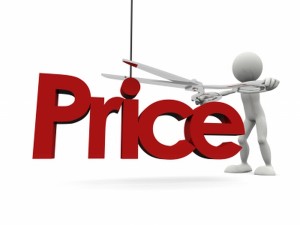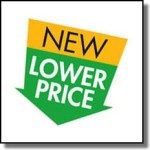I have totally updated my views on this topic. Back in 2013, this was a good strategy, but now it’s totally outdated. Here my my most up to date teaching on this topic:
How to Decide if You Should Lower Your Price (or Hold Your Price)
![]()
Sometimes it’s inevitable. You’re not going to get the price you want for an item you’re selling. This happens all the time online and in retail stores. Even brick and mortar stores understand it’s a good idea to lower their prices in order to move inventory. Most retail stores lower their prices because they just don’t have shelf space for the few items they have left. Other stores lower their prices because of a change in seasons. As a reseller, we love it when they lower the prices and move these items to a clearance section. In fact, we usually capitalize on these clearance items. But the issue of lowering prices is a whole different story with Amazon resellers.
There are many different reasons someone might want to lower their price on Amazon. Some sellers are just not patient enough to wait for their item to sell at their price. They don’t know that some products sell hundreds a day and that they may have the sale sooner than they think. Other sellers have a business model that is mainly focused on the super fast sale. They want to get the sale as fast as possible and turn that profit back into more inventory. Some people think that if an item sits in the warehouse too long, then it’s wasting capital they can use to get better selling inventory. This type of business model is more focused on the fast nickel instead of the slow dime. If an item hasn’t sold fast enough, then they lower their prices in order to get the fast sale.
I think a better business model includes products that are both fast nickel as well as slow dime. A healthy FBA inventory will have both products that sell quickly and products that sell slowly.
I almost never lower price… especially with Christmas coming up. For most items (there are exceptions) I may lower my price if the product has been sitting in my inventory for over a year. A whole year’s cycle is a good snapshot to see if an item will sell. If it doesn’t sell in a year, then I may lower the price, but if the rank is good, then I probably won’t lower it to match the lowest current price. If the rank is poor, then I’ll lower the price somewhat. If the rank is really bad, then I will most likely lower my price to match the current low price (FBA or not).
I am usually a patient person. And being patient has, more often than not, paid off in my pocketbook. I look at the pricing trends on Keepa and make educated pricing decisions. I know some items will sell for $20 in the summer, but will sell for $80 over the Christmas holidays. I can wait a few months for that kind of ROI (return on investment), especially when monthly storage fees are usually only a few pennies per item.
 Another time I’ll lower my price is for the items that are subject to a long term storage fee. After 365 days of an item being stored in an Amazon warehouse, FBA conducts an inventory cleanup. After 1 year, any inventory units that have been in a FBA warehouse for over 365 days will be assessed a fee of $22.50 per cubic foot. This is a HUGE fee and is to be avoided at all costs. Around two months before the long term storage fees hit, I’ll search my inventory and find the items that might be charged with this fee. Most of the time, I’ll lower my prices to match the lowest price in the hopes that they will sell before the fee hits. Amazon is even kind enough to send you a few warning emails that this fee is approaching, along with a link where you can see what items you are selling apply for the fee.
Another time I’ll lower my price is for the items that are subject to a long term storage fee. After 365 days of an item being stored in an Amazon warehouse, FBA conducts an inventory cleanup. After 1 year, any inventory units that have been in a FBA warehouse for over 365 days will be assessed a fee of $22.50 per cubic foot. This is a HUGE fee and is to be avoided at all costs. Around two months before the long term storage fees hit, I’ll search my inventory and find the items that might be charged with this fee. Most of the time, I’ll lower my prices to match the lowest price in the hopes that they will sell before the fee hits. Amazon is even kind enough to send you a few warning emails that this fee is approaching, along with a link where you can see what items you are selling apply for the fee.
There are currently only two times I pull certain inventory that has not sold. The first reason is if the sales rank is too high paired with the profit margin being too low. If I have a book with a sales rank of 7 million that I’ll only make a few bucks on, then I’ll have it sent back to me. The second reason I have items sent back is if they qualify for the long term storage fees (and don’t sell after I lower my prices, as stated above). Most likely, I’ll add these returned items to a box I keep at home for stuff I want to sell next time I have a garage sale.
So what about you? When do you like to lower your prices? What are your reasons? We’d all love to hear what you have to add to the conversation.

I’m still somewhat new to Amazon FBA. Early on I sent in a lot of books and media from my house and free items I’ve picked up around the neighborhood. Most items I price at what ever the current FBA rate was and let it ride. I sold a fair share of those items but then they just stopped selling. I don’t tend to look at the selling price of my inventory vs. others but recently began to. I noticed that many of my books that had a few sellers and a somewhat consistent prices now had many sellers and the price had completely fallen out. Even though I felt that they were somewhat of a lost cause, I have just recently lowered the price a bit but not down to the penny book rate are now going for.
While it was disappointing that these books I did not pay for were loosing value, this trend has started to permeate other areas of products that I have purchased. Since I have a small budget I primarily stick to the 3X rule when scanning. Lately I’m finding that many of the items I’ve sent in are now retailing for just over what I paid for them. If I were to drop my prices to that level I’d be loosing money on each item. Many of those items are household items.
There was a health and beauty item I was sending in that I paid $1.99 for and it was consistently selling for $7.99 but now it sell for 40 cents and the stock is hundreds deep. I have no idea how to compete with that.
I also have toys that I sent in that retail for $29.99; I paid $3.99 for these items. At the time there were no FBA sellers. I matched the price of the non-FBA sellers and added usually $3.99 to get the Prime buyers. Now these toys are selling for what I paid for them by FBA sellers. I can’t compete with that. I’ve been told to hold my price and eventually the other sellers will sell out and I plan to. The problem is this completely kills my cash flow.
I feel like the guy who consistently bets on the wrong horse at the track no matter what the stats show to be the likely winner.
Anyway just needed to vent, I’d gladly listen to any advice you might offer.
Thank you
-Troy
Thanks for posting this. I want to sell things to turn around quickly; however, I don’t want to lose money. I try to price my items in the general area of the other FBA sellers, but waiting for that sale is killer, especially when you’re new. I have wondered about the timing of repricing, so I really appreciate the words of caution about dropping prices, and I especially appreciate the tips about when it is time to reprice of pull inventory. Keep up the good work!
You might want to give Pricezombie a try. It will let you access sales rank from their browser extension, so its one less click to find the trend info.